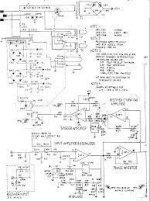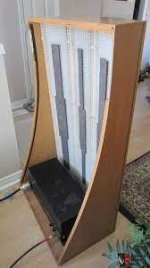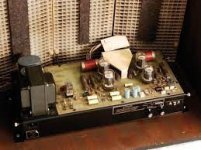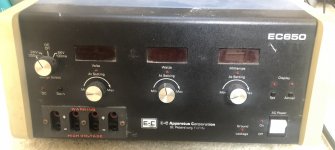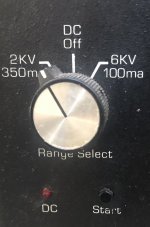Hi all, I'm trying to sort out which Acoustat models had built-in tube amps. Also would like to know the tubes Acoustat used? Thanks!
I believe there is a whole tread on this. I had a pair of the big 3-panel powered jobbies in my living space for awhile. They needed work. I believe they used transmitter tubes as you ar edealing with something like 5000 volts.
Must be rare, google cannot seem to find a picture.
dave
Must be rare, google cannot seem to find a picture.
dave
Check with the acoustatanswerman, of course.
https://www.diyaudio.com/community/members/acoustatanswerman.168330/
https://www.diyaudio.com/community/members/acoustatanswerman.168330/
These the ones? I’m sure I remember running into a pair back in the day, maybe that was at the mountain, before the stacked model 2s
Attachments
Thanks all. I've found a little info that suggests the 'X' model was the only one that had an internal amp, and they originally used 6HB5?
The original vacuum tube in Acoustat's Servocharge amplifier is 6HB5. During its years of production, I believe that was the only tube used by Acoustat. There may be others that work - I can't advise on that.
The original Model X was available ONLY with the Servocharge amplifer. Models Monitor 3 and Monitor 4 were available with either the Servocharge amplifier, or the original MK-121 (aka MK-121-1, or MK-121-1A) transformer interface. Note the original MK-121 and the Servocharge amplifier have the same mounting requirements, making the use of either method convenient. After the Monitor series, all speakers were available with transformer interfaces ONLY.
The original Model X was available ONLY with the Servocharge amplifer. Models Monitor 3 and Monitor 4 were available with either the Servocharge amplifier, or the original MK-121 (aka MK-121-1, or MK-121-1A) transformer interface. Note the original MK-121 and the Servocharge amplifier have the same mounting requirements, making the use of either method convenient. After the Monitor series, all speakers were available with transformer interfaces ONLY.
Sorry to go (slightly) OT, but can anyone point me to a schematic of the original, servo-charge footprint- compatible MK-121 interface? I’m taking care of a pair of X’s where the channel imbalance follows the interface. I have the diodes and caps, but am hesitant to open anything up since it works so well after >40 years…
Not sure why you are hesitant to change diodes and caps in the interface, and yet you're willing to take on the servocharge amplifier? There are many fans of the servocharge amps, but know that owning them involves a whole new level of commitment, as opposed to the nearly-carefree ownership of transformer interfaces. If you have a channel imbalance that follows the interface, you almost certainly have low bias voltage, which is almost always repairable with replacement of diodes and caps in the multiplier. I suggest replacing them in both interfaces, as they are known to go bad eventually.
Hi AAM,
I'm not the OP... I had the opportunity to buy a pair of Servo-amps for repairs @$400 and chickened out 😵
Will replace the diodes/caps as soon as I can find the box they're in.
Thanks
I'm not the OP... I had the opportunity to buy a pair of Servo-amps for repairs @$400 and chickened out 😵
Will replace the diodes/caps as soon as I can find the box they're in.
Thanks
Thanks all, got a clean schematic off the engine - exotica ":^)
Hey Acoustat Man may I ask why the half voltage filament mode is in there? Was it just to wake up quicker?
Hey Acoustat Man may I ask why the half voltage filament mode is in there? Was it just to wake up quicker?
The series/parallel arrangement of the tube heaters was indeed to make the amp "come alive" quicker. But, I also vaguely remember something about a turn-on delay for the high voltage. If that's true, then the sequence of events at turn-on is important, and neither circuit should be modified without knowing exactly what you're doing. Which I don't. I witnessed a lot of servocharge amps being repaired at the factory, and I always kept a respectable distance, both physically and mentally. 😉
I witnessed a lot of servocharge amps being repaired at the factory, and I always kept a respectable distance, both physically and mentally. 😉
LOL! I can relate, or sort of relate.
I actually own Beveridges and they have a similar amp. But the Bev has only one power transformer and no soft start or warm up process at all. So the B+ comes on instantly while the tubes are still cold. They also run the chosen tubes at roughly double their maximum DC voltage. Not the gentlest approach, for sure. The Acoustat staggered start is way better.
Again thank you for the information!
$400.00 is well worth it imo. Cost to rebuild them is in the $500.00 range per amp so $1500 for a new pair of servos is very reasonable. You now don't know you're seriously missing out. The reliability issue is way over the top out of proportion. The KingHi AAM,
I'm not the OP... I had the opportunity to buy a pair of Servo-amps for repairs @$400 and chickened out 😵
Will replace the diodes/caps as soon as I can find the box they're in.
Thanks
 is to you now dead.
is to you now dead.The Bev's don't have an on/off switch therefore you will not need to have a soft start.... The DC voltage is not too high either for the tubes as these can handle 7kv each (so actually they run on half the voltage they can handle therefore they last for ages even when never switched off, or because of this...).But the Bev has only one power transformer and no soft start or warm up process at all. So the B+ comes on instantly while the tubes are still cold. They also run the chosen tubes at roughly double their maximum DC voltage. Not the gentlest approach, for sure.
- Home
- Loudspeakers
- Planars & Exotics
- A question on Acoustat history
